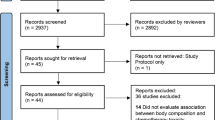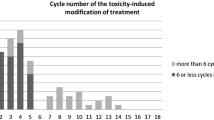Abstract
Purpose
Although body composition has emerged as an important predictor of drug efficacy and toxicity, explanations for this association are unclear. Our goal was to investigate relationships between lean body mass (LBM), liver size/function and epirubicin pharmacokinetics (PK) and toxicity.
Methods
Data from a clinical study (n = 24) of patients with breast cancer receiving adjuvant intravenous FE100C chemotherapy were used to examine relationships between LBM, liver size, and epirubicin clearance. Muscle tissue and liver mass were measured by analysis of computerized tomography cross-sectional images, and an extrapolation of muscle mass to total LBM compartment was employed. Population PK analysis of epirubicin was undertaken to test effects of body composition on epirubicin clearance and area under the curve (AUC).
Results
Estimated LBM was extremely variable in this cohort ranging from 32.9 to 67.3 kg. LBM was associated with neutrophil nadir (r = 0.5, P = 0.023), and mean LBM was lower for patients presenting with toxicity compared to those where toxicity was absent (41.6 vs. 56.2 kg, P = 0.002); 33% of variance in clearance was explained by LBM and aspartate aminotransferase (AST). Liver mass was not related to epirubicin clearance likely due to larger livers presenting with larger fat content, but liver attenuation (degree of fat infiltration) and AST were associated with AUC.
Conclusion
To our knowledge, this is the first study to examine relationships between LBM, liver mass/function and epirubicin PK and toxicity. This exploratory work investigates the notion of organs and tissues having distinctive contributions to the distribution and metabolism of antineoplastic drugs.



Similar content being viewed by others
References
Gurney H (1996) Dose calculation of anticancer drugs: a review of the current practice and introduction of an alternative. J Clin Oncol 14:2590–2611
Sawyer M, Ratain MJ (2001) Body surface area as a determinant of pharmacokinetics and drug dosing. Invest New Drugs 19:171–177
Ratain MJ (1998) Body-surface area as a basis for dosing of anticancer agents: science, myth, or habit? J Clin Oncol 16:2297–2298
Miller AA (2002) Body surface area in dosing anticancer agents: scratch the surface! J Natl Cancer Inst 94:1822–1823
Baker SD, Verweij J, Rowinsky EK, Donehower RC, Schellens JH, Grochow LB, Sparreboom A (2002) Role of body surface area in dosing of investigational anticancer agents in adults, 1991–2001. J Natl Cancer Inst 94:1883–1888
Chabner B, Lowis D (2006) Cancer chemotherapy and biotherapy: principles and practice. Lippincott Williams & Wilkins, Philadelphia
Arcamone F, Lazzati M, Vicario GP, Zini G (1984) Disposition of 14C-labelled 4′-epidoxorubicin and doxorubicin in the rat. A comparative study. Cancer Chemother Pharmacol 12:157–166
Morgan DJ, Bray KM (1994) Lean body mass as a predictor of drug dosage. Implications for drug therapy. Clin Pharmacokinet 26:292–307
Baker SD, Grochow LB, Donehower RC (1995) Should anticancer drug doses be adjusted in the obese patient? J Natl Cancer Inst 87:333–334
Prado CM, Baracos VE, McCargar LJ, Mourtzakis M, Mulder KE, Reiman T, Butts CA, Scarfe AG, Sawyer MB (2007) Body composition as an independent determinant of 5-fluorouracil-based chemotherapy toxicity. Clin Cancer Res 13:3264–3268
Prado CM, Baracos VE, McCargar LJ, Reiman T, Mourtzakis M, Tonkin K, Mackey JR, Koski S, Pituskin E, Sawyer MB (2009) Sarcopenia as a determinant of chemotherapy toxicity and time to tumor progression in metastatic breast cancer patients receiving capecitabine treatment. Clin Cancer Res 15:2920–2926
Lieffers JR, Mourtzakis M, Hall KD, McCargar LJ, Prado CM, Baracos VE (2009) A viscerally driven cachexia syndrome in patients with advanced colorectal cancer: contributions of organ and tumor mass to whole-body energy demands. Am J Clin Nutr 89:1173–1179
Gurney HP, Ackland S, Gebski V, Farrell G (1998) Factors affecting epirubicin pharmacokinetics and toxicity: evidence against using body-surface area for dose calculation. J Clin Oncol 16:2299–2304
Camaggi CM, Strocchi E, Carisi P, Martoni A, Melotti B, Pannuti F (1993) Epirubicin metabolism and pharmacokinetics after conventional- and high-dose intravenous administration: a cross-over study. Cancer Chemother Pharmacol 32:301–309
Prado CMM, Birdsell L, Baracos VE (2009) The emerging role of computerized tomography in assessing cancer Cachexia. Curr Opin Support Palliat Care 3(4):269–275
Prado CM, Lieffers JR, McCargar LJ, Reiman T, Sawyer MB, Martin L, Baracos VE (2008) Prevalence and clinical implications of sarcopenic obesity in patients with solid tumours of the respiratory and gastrointestinal tracts: a population-based study. Lancet Oncol 9:629–635
Bonneterre J, Roche H, Kerbrat P, Bremond A, Fumoleau P, Namer M, Goudier MJ, Schraub S, Fargeot P, Chapelle-Marcillac I (2005) Epirubicin increases long-term survival in adjuvant chemotherapy of patients with poor-prognosis, node-positive, early breast cancer: 10-year follow-up results of the French Adjuvant Study Group 05 randomized trial. J Clin Oncol 23:2686–2693
Mitsiopoulos N, Baumgartner RN, Heymsfield SB, Lyons W, Gallagher D, Ross R (1998) Cadaver validation of skeletal muscle measurement by magnetic resonance imaging and computerized tomography. J Appl Physiol 85:115–122
Heymsfield SB, Wang Z, Baumgartner RN, Ross R (1997) Human body composition: advances in models and methods. Annu Rev Nutr 17:527–558
Shen W, Punyanitya M, Wang Z, Gallagher D, St-Onge MP, Albu J, Heymsfield SB, Heshka S (2004) Total body skeletal muscle and adipose tissue volumes: estimation from a single abdominal cross-sectional image. J Appl Physiol 97:2333–2338
Mourtzakis M, Prado CMM, Lieffers JR, Reiman T, McCargar LJ, Baracos VE (2008) A practical and precise approach to quantification of body composition in cancer patients using computed tomography images acquired during routine care. Appl Physiol Nutr Metab 33:997–1006
Gallagher D, Belmonte D, Deurenberg P, Wang Z, Krasnow N, Pi-Sunyer FX, Heymsfield SB (1998) Organ-tissue mass measurement allows modeling of REE and metabolically active tissue mass. Am J Physiol 275:E249–E258
Kuk JL, Katzmarzyk PT, Nichaman MZ, Church TS, Blair SN, Ross R (2006) Visceral fat is an independent predictor of all-cause mortality in men. Obesity (Silver Spring) 14:336–341
Ricci C, Longo R, Gioulis E, Bosco M, Pollesello P, Masutti F, Croce LS, Paoletti S, de Bernard B, Tiribelli C, Dalla Palma L (1997) Noninvasive in vivo quantitative assessment of fat content in human liver. J Hepatol 27:108–113
Fogli S, Danesi R, Innocenti F, Di Paolo A, Bocci G, Barbara C, Del Tacca M (1999) An improved HPLC method for therapeutic drug monitoring of daunorubicin, idarubicin, doxorubicin, epirubicin, and their 13-dihydro metabolites in human plasma. Ther Drug Monit 21:367–375
Sierevelt IN, van Oldenrijk J, Poolman RW (2007) Is statistical significance clinically important?—A guide to judge the clinical relevance of study findings. J Long Term Eff Med Implants 17:173–179
Cosolo WC, Morgan DJ, Seeman E, Zimet AS, McKendrick JJ, Zalcberg JR (1994) Lean body mass, body surface area and epirubicin kinetics. Anticancer Drugs 5:293–297
Twelves CJ, Dobbs NA, Michael Y, Summers LA, Gregory W, Harper PG, Rubens RD, Richards MA (1992) Clinical pharmacokinetics of epirubicin: the importance of liver biochemistry tests. Br J Cancer 66:765–769
Nawaratne S, Brien JE, Seeman E, Fabiny R, Zalcberg J, Cosolo W, Angus P, Morgan DJ (1998) Relationships among liver and kidney volumes, lean body mass and drug clearance. Br J Clin Pharmacol 46:447–452
Acknowledgments
We thank Laura Birdsell for her assistance with body composition analysis, Linda Harris for her bibliographic expertise, Edith Pituskin, Sambasivarao Damaraju, Andrew G. Scarfe, Mark Clemons, Katia Tonkin, Heather-Jane Au, Sheryl Koski, Anil A. Joy, Michael Smylie, Karen King and Diana Carandang for their assistance with data collection. Roche Fellowship in Translational Research from Alberta Cancer Foundation (CMMP), Alberta Heritage Foundation for Medical Research (AHFMR) Fellowship (CMMP), Canadian Breast Cancer Research Alliance (MBS), Alberta Cancer Foundation (ACF) and Canadian Institute of Health Research (MBS). The authors had full control of all primary data and agree to allow the journal to review the data if requested. M. B. Sawyer—Research and Travel (ASCO) Funding from Pfizer Oncology, J. R. Mackey—Honoraria from Pfizer Oncology.
Author information
Authors and Affiliations
Corresponding author
Rights and permissions
About this article
Cite this article
Prado, C.M.M., Lima, I.S.F., Baracos, V.E. et al. An exploratory study of body composition as a determinant of epirubicin pharmacokinetics and toxicity. Cancer Chemother Pharmacol 67, 93–101 (2011). https://doi.org/10.1007/s00280-010-1288-y
Received:
Accepted:
Published:
Issue Date:
DOI: https://doi.org/10.1007/s00280-010-1288-y




